Marking India’s 79th Independence Day from the Red Fort, Prime Minister Narendra Modi issued a strong call to action for the country’s scientists, engineers, and defence industry to design and build indigenous fighter jet engines. He described the move as vital for achieving true defence self-reliance under the Atmanirbhar Bharat vision.
“Today, I urge the young scientists, talented youth, engineers, professionals, and all departments of the Government that we should have our jet engines for our own Made-in-India fighter jets,” PM Modi said, addressing the nation during his 12th consecutive Independence Day speech.
The Prime Minister linked the appeal to the recent success of Operation Sindoor, calling it proof of India’s advanced military capabilities. “Operation Sindoor showcased the marvel of India’s military prowess, leaving our enemies stunned and unable to comprehend the advanced arms and ammunition that neutralised them in mere seconds,” he added. Modi stressed that without the Atmanirbhar Bharat approach, such decisive missions would have been far more difficult to execute.
Push for Indigenous Fighter Jet Engines
India’s indigenous fighter programme continues to expand, but foreign engine dependence remains a bottleneck. Hindustan Aeronautics Limited (HAL) recently received its second US-made GE-404 engine for the Light Combat Aircraft (LCA) Mark 1A programme, with 12 more scheduled for delivery by the end of the financial year.
Delays in US shipments, driven by global supply chain disruptions, have intensified efforts to develop home-grown alternatives. India is now exploring co-development partnerships with Rolls-Royce (UK), Safran (France), and a Japanese defence manufacturer, all of whom have offered technology transfer and joint production. The Defence Research and Development Organisation (DRDO) is currently evaluating these proposals, according to Bloomberg.
Urgency to Bridge Combat Readiness Gap
Air Chief Marshal A P Singh recently warned that equipment delays threaten national defence readiness, noting the air force needs to induct around 40 fighters annually to maintain combat strength. At present, India operates 30 active squadrons — well below the authorised 42.5 — widening the gap in aerial defence capability.
Atmanirbhar Bharat Beyond Defence
PM Modi also encouraged citizens to support Atmanirbhar Bharat by prioritising locally made products, emphasising that such choices strengthen both the economy and national security. In a separate announcement, he reported progress on India’s semiconductor mission, promising that domestically produced chips would reach the market by year-end.
With global security dynamics shifting and supply chain risks persisting, Modi’s push for indigenous fighter jet engine development signals a clear strategic priority: ensuring India’s defence capabilities are built on its own technological foundation.













